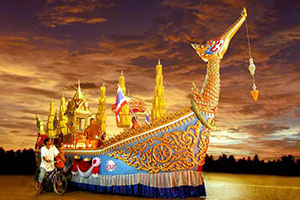Rating: 3.4/5 (5 votes)
Tradition of Chak Phra

Opening days: Daily
Opening hours: 08.00 - 17.00
Tradition of Chak Phra The period of dragging the Buddha image is done on the day of the Buddhist Lent, which is the first day of the waning moon of the 11th lunar month by agreeing to make an appointment to drag the monk to the center.
The importance is the tradition of making merit on the end of Buddhist Lent. follow the belief When the Lord Buddha went to stay in the Daowadung heaven to please his mother At the end of the Buddhist Lent, he returned to the human world. Buddhists go to pick him up and summoned the Lord Buddha to sit on the Busabok and parade
Nom Phra Nom Phra means the Phanom Phra is a vehicle used to carry amulets. They are used in 2 ways: dragging amulets by land called Phra Nom Phra, dragging amulets by water, called "Phra Boats". There are two pieces of wood to support the bottom. Made in the shape of a serpent with 4 wheels under the naga's body. The horse shop uses bamboo to weave the wall. Decorate with beautiful paint patterns around it.
Decorated with colored satin cloth, striped flags, three-man flag, railing flags, standing flags hanging with rubber bands Decorate with banana trees, sugarcane trees, coconut lanes, fresh flowers to make ubi There is boiled soup wrapped in banana leaves and hung in front of the monk's milk. The Naga body is decorated with colorful mirrors. Beside the Buddha image, hang phon, drums, bells, and gongs. Behind the monk's milk, a chair is placed. is the seat of monks The top of the milk is on the top of the monk's milk. It has been meticulously decorated with special care. Because the majesty of the royal milk depends on the top of the milk.
Bringing the Buddha image to be enshrined on the Buddha image. Phra Drag is a standing Buddha image. but popular is Buddha image in the posture of giving alms On the 15th day of the waxing moon of the 11th lunar month, the Buddha Company will pour water on the Buddha image and change robes. then summoned to be enshrined on the milk of the Buddha Then the monks will preach about the Buddha's visit to Daowadung. In the early morning, on the first day of the waning moon of the 11th month, villagers come to offer alms in front of the monk's milk, called Alms in front of the wheel. finished, then brought the Buddha image to be enshrined on top of the monk's milk At this time, some temples perform superstitious ceremonies to ensure smooth and safe hauling of monks.
To drag the Buddha image, use the rope to tie it into 2 strings, a female line and a male line, by using the phon (puet), gong, and bell as a tool to beat the provocative rhythm in dragging the Buddha image. The drags would crowd together and rejoice and chant the chant of the monks to relieve their strength.
Example of a song used to drag a monk's necklace: Yi Sarapa, Hello, Hello, round, round nipples, young girls, long long jars, young girls like
Tradition It is an expression of solidarity. Unity and unity in making merit Therefore, the content and importance are as follows: villagers believe virtue of dragging monks will make seasonal rain believing that "When the monk hides from his back, it will rain heavily." So the monk's milk created the symbol of the serpent. because it is believed to give water The dragging of monks is therefore related to the way of life of the people in the agricultural society.
It is a tradition that adheres to the belief that Anyone who drags a monk every year will receive a lot of merit, resulting in success in life. So when the monk's milk dragged through the front of someone's house The people in the house will come out to help drag the monks. and other villagers will continue to receive and drag the monks uninterrupted.
Inspired compose verses for singing while helping to drag monks which are often short poems, funny, humorous and interactive, training both wisdom and wit.
![]() Category: Art, Culture and Heritage
Category: Art, Culture and Heritage
![]() Group: Art, Craft Centres, Tradition
Group: Art, Craft Centres, Tradition
![]() Last Update : 6 MonthAgo
Last Update : 6 MonthAgo

